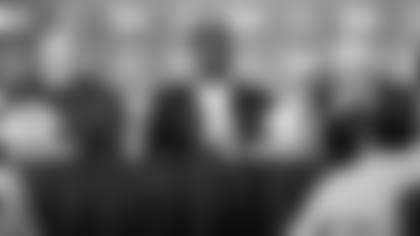For three decades, the Dallas Cowboys dynasty of the 1990s has been attributed for the most part to the Herschel Walker trade, a.k.a. "The Great Trade Robbery," and the subsequent draft picks that came along with it. That's partly accurate, too. No one is disputing that Emmitt Smith, Russell Maryland, Kevin Smith and Darren Woodson, all selected with picks from the deal, didn't help win three Super Bowls.
However, somewhat lost to history is the 1989 NFL Draft, the one before the most memorable and lopsided trade since the Louisiana Purchase.
This was the first under Jimmy Johnson, less than two months after Jerry Jones purchased the team. The upheaval for the Cowboys and the NFL during the seven weeks between the sale in February and the draft that April is simply mind boggling. Jones buys the Cowboys, fires Tom Landry, hires Johnson, Pete Rozelle announces he will soon step down as league commissioner after 29-plus years, Ring of Honor and Hall of Famer Randy White retires after 14 seasons with Dallas, and Cowboys President Tex Schramm, either the first or second most powerful man in professional football for 30 years, resigns.
Whew. Quick breather.
In the midst of that whirlwind was the everyday storyline of the No. 1 overall pick. Having finished 3-13 the season before, the Cowboys were in possession of that first selection, and while they could have just come out and said what everyone sort of, kind of, knew anyhow, that they would select UCLA quarterback Troy Aikman, Johnson decided against that mindset.
Once Dallas signed Aikman, three days before the draft on April 20, Johnson said he figured listening to trade offers and corresponding with front offices would be a good experience for a first-year NFL head coach who was also calling the personnel shots.
"Troy has the talent to take the Cowboys back to where we all want them to be," Johnson said at the time. "You'd be amazed at what some of the teams were willing to give up (in a trade) for Troy. But we've known that this was our guy."
Even minus Twitter, rumors were rampant in the weeks before Dallas inked its franchise signal-caller. Kansas City and San Diego were willing to pay an unprecedented ransom while Chicago was willing to deal at least two if not all three of its first-round picks so they could take Michigan State offensive tackle Tony Mandarich.
This falls into the same category as half the league's general managers would have taken Ryan Leaf over Peyton Manning. Just doesn't seem possible, an urban myth of the highest accord. Thing is, Aikman was the not the consensus No. 1 overall pick. Heck, some in the Cowboys' scouting department thought Mandarich was the guy, never mind Barry Sanders, Derrick Thomas or Deion Sanders, all eventual Pro Football Hall of Famers who rounded out the top 5. ("Prime Time" was the second player on Johnson's board.)
As for Mandarich, he went from Sports Illustrated's pre-draft cover boy with the headline, "The Incredible Bulk," to a second cover a few years later titled, "The NFL's Incredible Bust."
What's most impressive about Johnson's initial rodeo is that Dallas didn't have any additional picks entering the draft, outside of a fifth-round selection picked up from Denver the previous offseason for the aging Tony Dorsett. Give Johnson all the credit in the galaxy, but it's a lot easier to draft with double-digit choices in the first four rounds, as he did in 1992 and 1993.
Another potential challenge was that Johnson was only on the job for seven weeks. As head coach of the University of Miami the previous year, the last thought on his mind was which prospects to draft. Sure, he was familiar with some of the players his squad faced, but scouting for a collegiate game and scouting for a pro career are distinctly different endeavors. Not only that, when one coaches a team for a season, they are acutely aware what the weaknesses are. When Johnson took the gig, he possessed zero knowledge of the Cowboys he was inheriting other than they had won three games.
From the start in Dallas, Johnson was working 16-hour days, 6:15 a.m. to 10:30 p.m., the lone break for a midway workout, but eating lunch and dinner in his office. Weekends included. Staff meetings, which included six assistants from Miami, started promptly at 7:30 each morning. His first month on the job, Johnson ate out twice, both times multitasking while doing a national magazine interview at a nearby Italian joint, Caesar salad and stuffed eggplant.
"This draft will probably be the most important one I'll ever have in the NFL," Johnson told Sports Illustrated in a March cover story. "We pick first. I want to be in a position where, three years from now, I can say we had a great draft. But even with a great draft, it's tough to change personnel overnight.
"I don't like people to say it will be a three-year project or a five-year project or whatever. I don't know how long it's going to take. But eventually, we're going to win in Dallas."
Worth noting here, just because it's difficult to fathom in today's world, that Johnson was working without a contract. Everything happened so quickly when Jones bought the franchise and so much needed to be done that the former Arkansas football teammates simply shook hands and started working. In March, when asked, Johnson said, "The length and money have not been determined. It's not a high priority with me."
Less than a month later, shortly before the draft, Johnson was finally signed for 10 years, Jones calling the deal a "no-cut contract." Reports put the terms at roughly $400,000 per year, twice what he was making at Miami.
While longtime personnel director Gil Brandt was still in charge of the ever-dwindling scouting department (Jones let 10 scouts go along with 78 other employees) heading into the draft, he was fired shortly thereafter on May 2. This was clearly Johnson's show. He traveled alone to UCLA in March to work out Aikman, later claiming that's when his decision became final. When they signed Aikman, Jones recalled receiving a phone call from his ecstatic head coach.
"He said, 'Man, you should see him,' and I just raised up and yelled into the phone," said Jones. "I was so excited. There was no decision to make here."
Weeks before the draft, Johnson also embarked on a 10-day cross-country trip that took him to 12 schools, working out players, watching film, talking with coaches, saying, "I'm grinding away on this thing night and day. I'm as excited right now as I've been since I took the job with the Cowboys."
(Sidenote: Over the years, Johnson's draft prep was slightly altered. He'd spend Saturdays at Tony Roma's, eating ribs with his sons and watching college games.)
Even with so much going on during the month before the NFL Draft, the dominant story was Aikman, Johnson and Jones refusing to commit publicly. Even other front office executives were flummoxed with New York Giants personnel director Tom Boisture saying, "I hope they don't take him. I wouldn't mind if he's not in our division. I couldn't imagine why Dallas wouldn't want him. They need a quarterback. Do you know of any team that has won without one?"
Nine days before the Cowboys would be on the clock, contract discussions began with Aikman's agent Leigh Steinberg (later the inspiration for the movie Jerry McGuire). Mike McCoy, the longtime oil and gas business partner of Jones, and at the time a minority team owner, handled most of the negotiations for Dallas. At this point, Jones had been on the record numerous times as saying Aikman may be too expensive. Two years earlier, Tampa Bay's Vinny Testaverde received a record breaking six-year, $8.2 million deal.
This wasn't a knockdown, drag-out negotiation, however, and within almost no time numbers were agreed upon – six years, $11.2 million, which made Aikman the third-highest paid player in the NFL in terms of average salary behind only Warren Moon and John Elway. Right behind the rookie were Jim Kelly and Dan Marino. Of course, all five quarterbacks are now in the Pro Football Hall of Fame.
The signing bonus canceled check for $2.75 million is framed to this day on the wall of Jones' study in his home.
At the press conference to announce the signing, Aikman said, "It's pretty much a dream come true for me, it's beyond words. I wanted this so badly, to be a Dallas Cowboy. (Growing up in Henryetta, Oklahoma) it seemed like every Sunday the Dallas Cowboys were on TV, and Roger Staubach was throwing the last-minute touchdown pass to win the ballgame.
"Coming in as the No. 1 player chosen, there will be added pressure. But there would have been pressure if I was the 100th player taken."
When the NFL Draft kicked off on Sunday, April 23, the Cowboys' first selection after Aikman, who indeed was the top pick taken, would be the 29th overall, the first of the second round. However, Johnson was already thinking quantity, a philosophy from which he never wavered when it came to the draft. So, when Los Angeles Raiders owner Al Davis called interested in that selection, Johnson knew the price tag.
"Jimmy, this is the first time we've dealt with one another. This could be a good experience," Davis said.
Johnson replied, "This is my first time, too. And Al, I need another pick."
The deal was struck. Dallas officially selected Steve Wisniewski and then promptly traded the future All-Pro guard, who the Raiders wanted with that 29th choice, and a sixth-rounder for Los Angeles' second, third and fifth-round picks. Johnson even talked Davis into giving him the higher of the team's fifth-rounders, always the wheeler and dealer.
"Even though we had some nervous moments, we went in wanting these three players," Johnson said at the time. "It got really interesting when we got down to the last few seconds with that trade."
Johnson then used the acquired choices on Syracuse fullback Daryl Johnston, Florida defensive end Rhondy Weston and Georgia Tech linebacker Willis Crockett, respectively. The latter two combined for just 25 NFL games, Weston the rare third-rounder to not even make the roster of the team that drafted him.
As for the soon-to-be "Moose," that one worked out quite well. The two-time Pro Bowler played 11 years in Dallas and led the way for all-time rushing leader Emmitt Smith while also catching 294 career passes.
Recently looking back on being selected by the Cowboys, Johnston said, "Completely out of the blue, completely out of the blue. Gil Brandt is who I talked to on the phone on draft day. (Coming down for minicamp) was just my third time east of the Mississippi River, so there was one of the guys who said, 'Wait until you get down to Texas. They're going to love you. They're going to love a Yankee down there.' I said, 'What are you talking about?'
"There was a little bit of nervousness in coming down, but I've made it my home. It's been great."
On his conference call with the Dallas media, Johnston said, "If you need three yards, I'll get you three and a half."
Almost true to his promise, his career rushing average was 3.2 yards per carry.
In the third round, Johnson selected another future Pro Bowler in Pitt center Mark Stepnoski. In fact, the first three players Johnson ever drafted for the Cowboys were each named among the top-60 players in the first 60 years of the franchise. Talk about impressive.
Undersized at 269 pounds, Stepnoski, a five-time Pro Bowl selection and two-time Super Bowl winner, was as technically sound as any center of his generation despite playing pulling guard in college. Tony Wise, the team's offensive line coach at the time, said, "He's a tough individual and a fine athlete. He is the sort of guy who will hit you in the mouth."
The original goal for the second round was a pass rusher, but when the two the Cowboys liked were off the board they went with the best overall player in Johnston. In the fourth round, they selected UTEP defensive end Tony Tolbert, who never missed a game over nine seasons with Dallas. The seven-year starter finished with 59 sacks, three Super Bowl rings and a Pro Bowl nod in 1996 behind a career-best 12 sacks.
Clemson tight end Keith Jennings was taken in the fifth round and only lasted a season with Dallas, catching six passes. He eventually hooked up with the Chicago Bears where he played 82 games with 101 receptions for 1,035 yards and 10 scores.
The only other draftee of note was 11th round linebacker Randy Shannon, who played just 17 games for Dallas over two seasons but later became the head coach at his alma matter, the University of Miami.
While this is another story entirely, Johnson shocked everyone, most of all Aikman, by taking Miami quarterback Steve Walsh in that following July's supplemental draft. This led to a massive controversy throughout the 1989 season, one in which Dallas went 1-15 with Walsh leading the team to its lone win, a 13-3 upset victory at Washington.
Today, Johnson claims he took Walsh just to trade him for more picks, which he did the following year to New Orleans for a first, second and third. Aikman doesn't completely buy that story, but no matter. There's no disputing the overwhelming success of Johnson's first draft with the Cowboys.
The Official 2022 Dallas Cowboys Star Magazine Draft Guide has comprehensive scouting reports on 110 players with more than 500 top prospects listed overall. Available in both print and digital, visitDallasCowboys.com/starfor more information and to purchase yours today!















